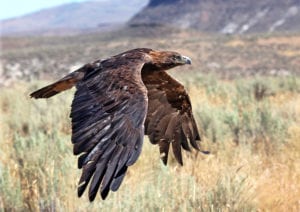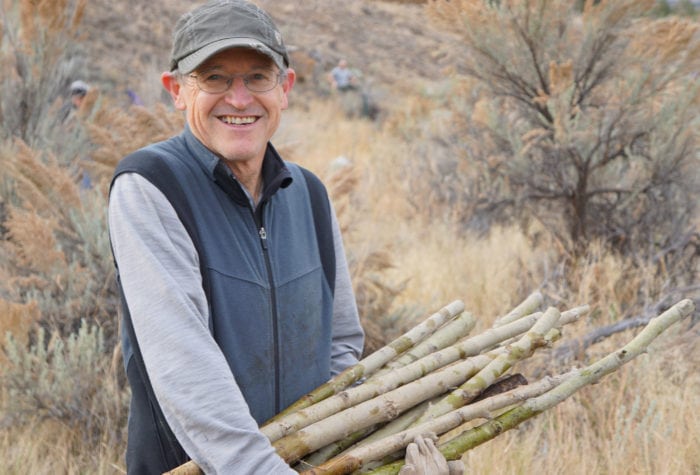What makes Sutton Mountain worthy of national monument designation?
 The largest contiguous expanse of public lands in the region, the rocky ridges, high plateaus, rolling grasslands and riverine habitats at Sutton Mountain are rich in wildlife, resplendent views and a host of recreational offerings. The landscape is home to bobcat, cougar, herds of mule deer and Rocky Mountain elk, supports myriad species of birds, including the iconic golden eagle, and erupts in desert wildflowers in spring. Bridge Creek and its tributaries weave through the monument and are designated critical habitat for threatened steelhead trout.
The largest contiguous expanse of public lands in the region, the rocky ridges, high plateaus, rolling grasslands and riverine habitats at Sutton Mountain are rich in wildlife, resplendent views and a host of recreational offerings. The landscape is home to bobcat, cougar, herds of mule deer and Rocky Mountain elk, supports myriad species of birds, including the iconic golden eagle, and erupts in desert wildflowers in spring. Bridge Creek and its tributaries weave through the monument and are designated critical habitat for threatened steelhead trout.
Sutton Mountain also features one of the richest concentrations of geological and paleontological resources in Oregon, preserving a staggering 50 million years of geologic activity, prehistoric fossils, and colorful layers of ancient lakebed sediments, volcanic ash, and basalt. The southern flank of Sutton Mountain is one of the best places to view a continuous geologic record in all of North America.
The proposed Sutton Mountain National Monument also includes four areas important for conservation and popular for recreation: Pat’s Cabin, Dead Dog, Sand Mountain and Gable Creek. These sites are favorites for locals and visitors alike to enjoy angling, hunting, horseback riding, swimming, camping, hiking and wildlife-watching. From atop Sutton, adventurers can enjoy spectacular vistas of the Painted Hills, John Day River, the Bridge Creek watershed and beyond, to the Ochoco National Forest.
Which federal agency would administer the national monument?
The Bureau of Land Management currently manages Sutton Mountain and the agency would continue to manage it as a national monument.
The National Park Service administers the John Day Fossil Beds National Monument, including the Painted Hills, and would continue to do so.
This dual management approach would allow each agency to manage to their strength, with the Park Service managing for preservation and visitation at the Painted Hills, and the Bureau of Land Management managing for wilderness values, fish and wildlife, cultural preservation, backcountry recreation, and continued livestock grazing on surrounding public lands.
How would national monument designation improve conservation and management of these public lands?
National monument designation will result in consistent, comprehensive management of Sutton Mountain for the purposes of ecological health and wildfire resiliency. The legislation establishes two, interconnected management zones to achieve these goals: an Upper Unit, where management would preserve wilderness values, and a Lower Unit, where compatible management is authorized to restore those public lands. It also authorizes land exchanges with local landowners to consolidate public ownership within the monument, and transfers certain lands to the city of Mitchell to manage for recreation and other public uses.
Will national monument designation change what types of activities are allowed on Sutton Mountain?
No. Visitors would continue to enjoy the same or greater access and opportunities currently offered on these public lands. The State of Oregon would continue to license and administer hunting and angling in the new designation. Livestock grazing would continue to be permitted within the monument.
Could a future president diminish this national monument as occurred with Bears Ears and Grand Staircase-Escalante in Utah?
No. Sutton Mountain National Monument would be established in law, rather than by presidential proclamation. Only Congress can act to eliminate or downsize a legislated national monument. Notably, the John Day Fossil Beds National Monument that includes the Painted Hills Unit is also a legislated national monument.
How will the proposed national monument conserve cultural resources and tribal interests?
The legislation specifically requires conservation, protection and improved management of tribal, cultural and archaeological resources and sites, as well as culturally significant native species in the monument. It also affirms that nothing about monument designation will affect treaty rights and privileges of any Indian Tribe.
What if Sutton Mountain becomes too popular? How will visitation be managed?
Nearly 200,000 people enjoyed the John Day Fossil Beds National Monument in 2019, and approximately 75,000 travelers paid a visit to the Painted Hills. This region is already well-known. One motivation for designating the Sutton Mountain National Monument is to protect and provide additional direction and resources for conserving and restoring the public lands surrounding the Painted Hills, while managing increased interest in the area.
To stay up-to-date as the Sutton Mountain National Monument proposal progresses and to learn more about other efforts to protect the most significant public lands in Oregon’s high desert, subscribe to ONDA’s e-newsletter.


 The largest contiguous expanse of public lands in the region, the rocky ridges, high plateaus, rolling grasslands and riverine habitats at Sutton Mountain are rich in wildlife, resplendent views and a host of recreational offerings. The landscape is home to bobcat, cougar, herds of mule deer and Rocky Mo
The largest contiguous expanse of public lands in the region, the rocky ridges, high plateaus, rolling grasslands and riverine habitats at Sutton Mountain are rich in wildlife, resplendent views and a host of recreational offerings. The landscape is home to bobcat, cougar, herds of mule deer and Rocky Mo